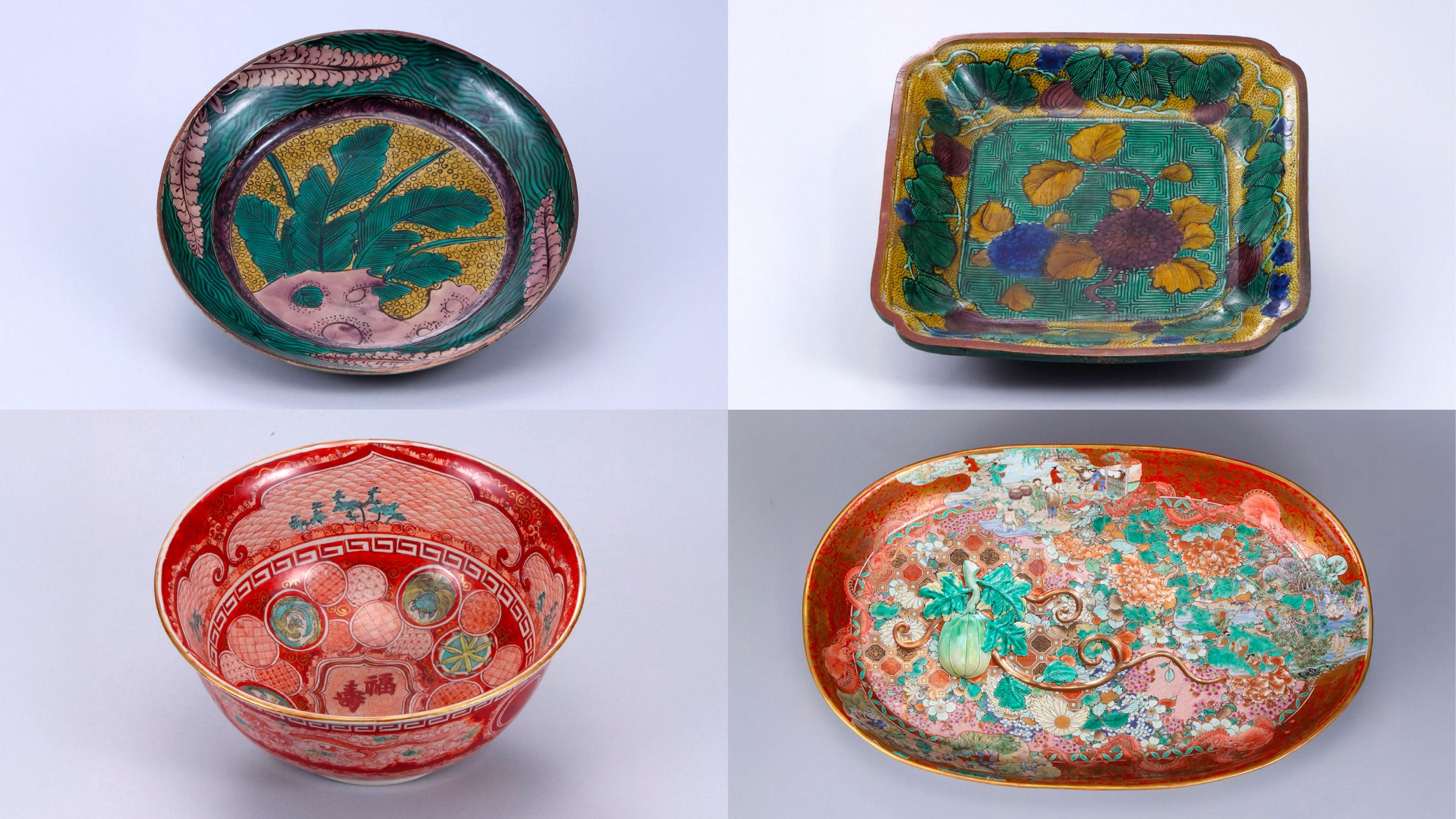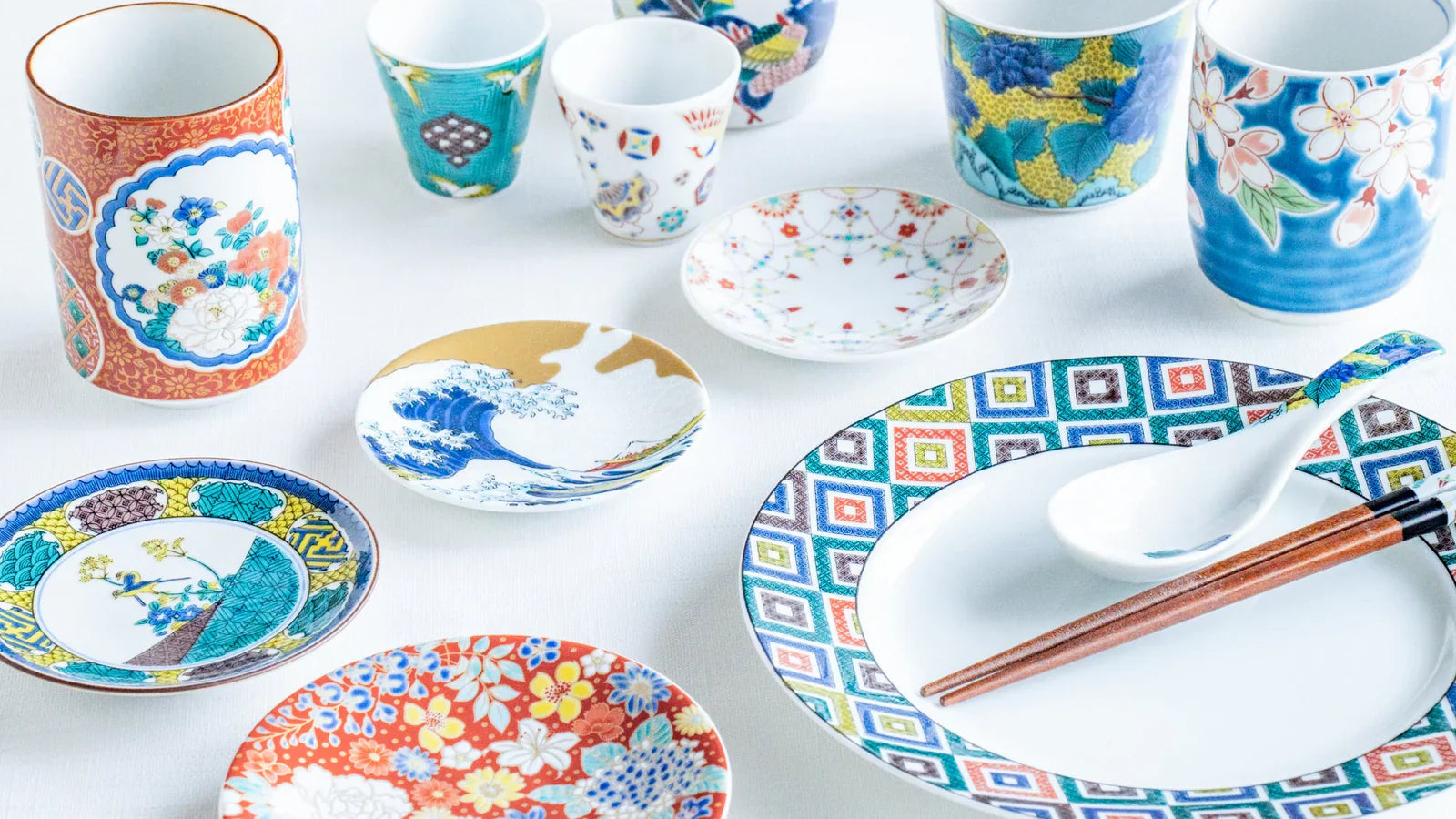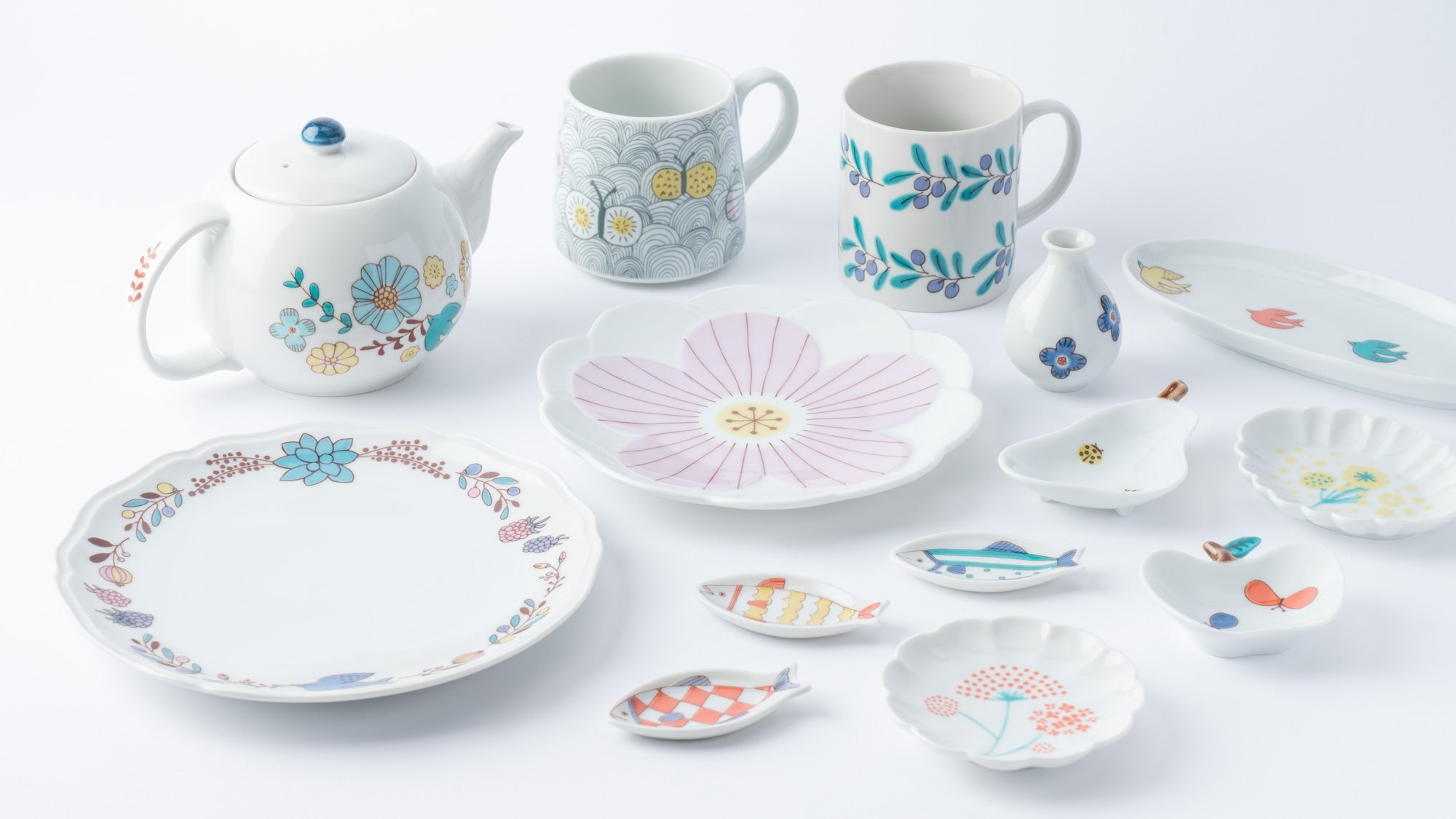
The History and Painting Styles of Kutani Ware: An Interview with Nakaya Shinichi, Director of The Kutani Porcelain Art Museum
Written by Team Japan Kutani
We spoke with Director Nakaya of The Kutani Porcelain Art Museum, a Kutani ceramics historian, about the history of Kutani ware and the artistic styles of each era.
TABLE OF CONTENTS
The Origins of Kutani Ware
Kutani ware dates back to 1655, during the early Edo period (1603–1868 CE). Its founder, Maeda Toshiharu, was the first lord of the Kaga Daishoji Domain and the grandson of Maeda Toshiie, a prominent figure in the Maeda clan.
The discovery of porcelain stone in the Kutani gold mines within his territory sparked the beginning of iroe porcelain production, known for its vivid overglaze enamels. A kiln was soon established in Kutani Village, where the stone was found, and operated for about fifty years. The works produced during this era later came to be known as ko-Kutani, or Early Kutani ware.

The Painting Style of Ko-Kutani
Unlike perfectly symmetrical or refined works, ko-Kutani is known for its bold, expressive energy—a dynamic beauty that feels almost alive. Its brushwork carries a raw power that stirs the soul, setting it apart from other ceramics of the time. There are two main painting styles in ko-Kutani.
Gosaide
This style uses five key colors—deep blue, red, purple, green, and yellow—and makes expressive use of empty space, much like traditional Japanese painting, to draw attention to the central motif.



Aote
This style features a palette of three colors—green, yellow, and purple—and occasionally deep blue. The entire surface is filled with bold strokes of color, creating an impression akin to an oil painting.



Although ko-Kutani incorporated techniques inspired by the Ming dynasty’s five-color (wucai) and three-color (sancai) porcelain, it did not simply replicate them. Instead, a completely original expression that was uniquely its own was crafted. Even when compared with other art and crafts from the 17th century, its creativity is remarkable.
Ko-Kutani is more than craft—it transcends even painting to become a true form of art. Its significance is recognized worldwide, with many pieces held in the collections of major Western museums.
Overglaze Enamel Porcelain in the Early Edo Period
During the early Edo period, when ko-Kutani ware was being produced, overglaze painting was still extremely rare in Japan. Imported Chinese porcelains decorated with overglaze enamels were so highly prized that they were valued on par with gold. At the time, Arita in Kyushu was the only region capable of producing such pieces, and even there, the process required remarkably advanced techniques.
Japan, being under sakoku, the policy of national isolation, access to new knowledge or methods from China was very limited. Given these circumstances, the emergence of Kutani ware’s overglaze enamel porcelain in the remote mountains of Kaga—far from Arita—was truly extraordinary.
To put it in perspective, it was like leaping from the age of radio straight to color television, skipping black-and-white altogether. That’s how revolutionary the appearance of Kutani ware was.
Why Kutani Ware Was Born in the Deep Mountains of Kaga
How could such refined overglaze enamel porcelain emerge from the remote village of Kutani? The answer lies in the strong support of the Maeda clan.
Seeking to demonstrate their cultural power to the Tokugawa shogunate and other feudal lords, the Maeda family pursued a vision of “conquering through culture.” They invited artists from the Kano and Rinpa schools, collected valuable imported works, and developed a deep appreciation for art.
When porcelain stone was discovered in Kutani, the clan launched a project to create overglaze enamels that would embody their ideals. With their wealth and influence, they introduced advanced techniques from Arita, gathered skilled artisans, and, guided by their refined taste in art, fostered the development of the distinctive style known as ko-Kutani.
Why Ko-Kutani Production Stopped after Fifty Years
There are many theories about why ko-Kutani production came to an end after roughly fifty years, but no definitive explanation exists. In fact, this very mystery adds to its enduring allure.
Possible reasons include the deaths of Toshiharu Maeda, the first lord of the Daishoji Domain, and his successor Maeda Toshiaki, as well as financial difficulties caused by famine, internal power struggles within the domain, and intervention by the Tokugawa shogunate.
It is difficult to attribute the decline to a single cause, but it is generally believed that a combination of factors ultimately led to the closure of the ko-Kutani kilns.
The Revival of Overglaze Enamel Porcelain, a Century After the Kilns Closed
About a hundred years after the kilns in Kutani Village were shut down, overglaze enamel porcelain production was revived in the Kaga and Daishoji domains. This period is known as “The Revival of Kutani.”
The movement began at the Kasugayama Kiln within the Kaga domain, where production resumed under the guidance of Aoki Mokubei, a renowned potter from Kyoto. There, Kyoto-style overglaze techniques such as gosu-akae were introduced.



Although Aoki was already a celebrated Kyoto potter, he made the journey to Kaga, saying, “This is the land where Kutani ware was once made—if the same materials still exist.” Even a century after ko-Kutani’s decline, its spirit continued to inspire artisans from Kyoto, the cultural center of Japan.
While Aoki eventually returned to Kyoto, Aoki’s apprentice, Honda Sadakichi, remained in Kaga, discovered Hanasaka porcelain, and went on to establish the Wakasugi Kiln.
Honda Sadakichi: Carrying Kutani Ware Into the Future
If not for Honda, Kutani ware might not exist as it does today. He accomplished two great achievements: discovering Hanasaka porcelain stone and training the next generation of artisans.
Originally, ko-Kutani used porcelain stone from the remote mountains of Kutani Village, where access was difficult. Determined to find a more practical source, Honda searched relentlessly—first in Kanazawa, then in Komatsu—until he finally discovered high-quality porcelain stone in Hanasaka. In an age without scientific methods, this discovery was the result of pure perseverance.
Even today, Hanasaka porcelain stone remains an essential raw material for Kutani ware—a testament to Honda’s enduring contribution to its production. At the Wakasugi Kiln, which he founded, many talented potters were trained and went on to shape the future of Kutani ware: Aoya Genemon, who became active at the Yoshidaya Kiln; Saida Dokai, who helped promote “Japan Kutani” overseas; and Kutani Shoza, who advanced its artistic expression.

While overglaze enamel porcelain was also produced at the Wakasugi Kiln, most pieces were in the sometsuke style—decorated solely with cobalt blue pigment—as this required fewer firings.

As the focus at the Wakasugi Kiln gradually shifted toward sometsuke production, the master overglaze painter Aoya joined the Yoshidaya Kiln, which sought to revive the traditions of ko-Kutani. Interestingly, the overglaze enamels made at Wakasugi Kiln during this period were not called Kutani ware but Wakasugi ware. At the time, the name “Kutani ware” was reserved only for porcelain produced in Kutani Village.
Yoshidaya Denemon: The Person Behind the Revival of Kutani Ware
The key figure in the revival of Kutani ware was Yoshidaya Denemon, a wealthy merchant of the Daishoji Domain and a distinguished patron of the arts. Deeply devoted to Kutani ware, he was determined to see it revived.
Yoshidaya invested his entire personal fortune—and even went into debt—to establish a kiln in Kutani Village, an inconvenient but symbolically important location known as the birthplace of Kutani ware. This kiln became known as the Yoshidaya Kiln, and by producing overglaze enamel porcelain once again in Kutani itself, it truly restored Kutani ware in its original form.



Many of the works produced at the Yoshidaya Kiln were reminiscent of the aote style of ko-Kutani, and letters from the time suggest that in Kyoto, Yoshidaya’s porcelain was praised for inheriting the techniques and style of ko-Kutani. The translucent depth of its pigments, combined with refined designs and elegant motifs, made Yoshidaya pieces exceptional in both artistry and quality. While they carried on the aesthetic spirit of ko-Kutani, their designs were entirely original, establishing a new form of expression within the tradition.
Just as Ko-Kutani had not imitated Chinese porcelain, so too did Yoshidaya Denemon—a cultured man devoted to reviving Kutani ware—and young talents like Aoya from the Wakasugi Kiln refuse to simply copy the old masters. The Yoshidaya Kiln inherited not only the outward style of Ko-Kutani but also its creative spirit: the freedom and boldness that defined Kutani ware from the beginning.
However, the kiln in Kutani Village operated for only about two years before moving to Yamashiro, likely due to the difficulties of working in such a remote location. Even so, Yoshidaya’s passion for reviving Kutani ware was well known, and its works were highly esteemed. They continued to be recognized as Kutani ware long after the move.
Despite its success, the Yoshidaya Kiln ceased production after seven years following the deaths of Denemon and his son, along with the heavy burden of debt. The kiln was later taken over by the head artisan and continued its legacy under the name Miyamotoya Kiln.
Miyamotoya Kiln and the Mastery of Akae-Saibyo
The Miyamotoya Kiln perfected the technique of akae-saibyo, or fine-line red painting, a style that remains highly admired today. Its chief artisan was Iiidaya Hachirouemon.
While the Yoshidaya Kiln had centered its work on the aote style, the Miyamotoya Kiln devoted itself entirely to the akae style, establishing a distinct artistic identity within the evolving world of Kutani ware.



Although red overglaze enamel was practiced in other regions, the Miyamotoya Kiln distinguished itself with exceptionally intricate and precise linework, achieving a level of detail unmatched elsewhere. This pursuit of originality over imitation once again reflected the enduring spirit of Kutani ware and led to the creation of a new style and technique known as akae-saibyo.
The Introduction of Kinrande Techniques to Kutani Ware
Later, at the main Kutani Kiln, which succeeded the Miyamotoya Kiln, Eiraku Wazen from Kyoto was invited as a technical advisor. Renowned for his skill in working with gold, Eiraku introduced the kinrande technique to Kutani ware, decorating red-painted vessels exclusively with gold. This marked the beginning of a new, richly decorative style that would become a hallmark of Kutani craftsmanship.



The fusion of kinrande and the akae-saibyo technique developed at the Miyamotoya Kiln gave rise to a new style known as akae-kinrande.
The Achievements of Shoza Kutani, the Leader of “Japan Kutani”
During the late Edo and early Meiji periods, Kutani Shoza emerged as a leading figure in the world of Kutani ware. He developed a new style known as saishoku-kinrande, which combined the overglaze enamel techniques of successive Kutani traditions dating back to ko-Kutani with subtle intermediate hues created using Western pigments.



This piece, considered one of Shoza’s greatest masterpieces, was exhibited at the first National Industrial Exposition in 1877. Incorporating the full range of decorative techniques used in Kutani ware, it represented an unprecedented level of opulence and refinement.
Both saishoku-kinrande and akae-kinrande were highly acclaimed in Japan and abroad, becoming some of the most sought-after Meiji-era exports known collectively as “Japan Kutani.”
Reflecting on the History of Kutani Ware
From ko-Kutani to its revival, we have traced the long and intricate history of Kutani ware and its evolving styles. Though each piece may appear as a single work of porcelain, every generation of kilns carries its own story—shaped by the era, the circumstances, and the hands and hearts of the artisans who created it. Few other ceramics hold such a layered and human narrative, and that is what makes Kutani ware so deeply captivating.
Throughout its history, Kutani ware has always been held in high esteem. While it has drawn inspiration from Chinese and Kyoto techniques and painting styles, it has continually pursued and refined its own originality. That creative spirit remains alive today, with countless contemporary artists each developing their own distinctive approach to Kutani ware, ensuring that its story continues to unfold.
Director Nakaya’s explanation highlights what makes Kutani ware so difficult to define in a single word. Its many techniques and styles—each distinct yet connected—together form a tradition rooted in diversity and originality.
From ko-Kutani onward, the philosophy of “not imitation, but the pursuit of originality” has guided its makers. That enduring creative spirit continues today, as countless interpretations of Kutani ware enrich daily life. Reflecting on its long history, one can’t help but feel gratitude toward Lord Maeda, whose vision for a new kind of overglaze enamels laid the foundation for everything that followed.
The Kutani Porcelain Art Museum, Gosaikan
The Kutani ware pieces introduced alongside Director Nakaya’s commentary can be viewed in person at Gosaikan of The Kutani Porcelain Art Museum. The museum also exhibits many other precious works, including aote pieces from the late Edo period and masterworks by modern artisans. It’s well worth a visit to experience firsthand the enduring beauty and depth of Kutani ware.








Leave a comment
This site is protected by hCaptcha and the hCaptcha Privacy Policy and Terms of Service apply.